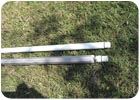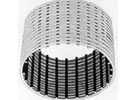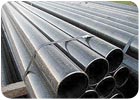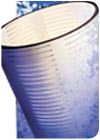
Well casing on top; fine-mesh stainless steel well screen on the bottom.
General Casing and Screen Considerations
Water has played a vital role in the advancement of mankind. The earliest traces of civilization reveal that those cultures that flourished were able to employ water sources for domestic and agricultural purposes. A characteristic of all developed countries today is their ability to productively use the water made available to them.While ground water use began in arid and semi-arid regions thousands of years ago, more recently, development has occurred in areas with ample surface supplies. This has provided supplemental sources for use by agriculture at the most beneficial time - during the growing season - and availability during drought conditions. Thus, a world ground water development industry has grown, focusing attention on water well construction techniques, design and operating methods.
Regardless of purpose, almost all water wells must be provided with a means of protecting the borehole and provision made for the entrance of water from surrounding aquifers. While well casing simply is defined as the material that cases or lines a borehole to prevent formation collapse, there are varied interpretations of the meaning of well screen. This is due to the existence of many designs throughout the world. In this article series, screen refers to that structure in a well, which protects the borehole, but allows the entrance of water. In this sense, screen is a filter.
The durability and efficiency of a well depend to a large degree on its design, construction procedures and selection of casing and well screen. However, casings and screens alone comprise the principal substance of a completed water well. While representing a fraction of total investment, they are critical to the productive life of a well and pump. In addition, yield and operating expenses are influenced. The latter has grown more important due to rapidly escalating energy costs.
Another matter attracting increased attention today concerns contamination of ground water supplies from harmful materials originating at the surface. Protection of a well requires controlling the pollution source. In many cases, the use of sealed casings and more durable materials is helpful.
This article discusses casing and screen materials in common use in the word today. It also sets forth the factors to be considered in their choice. These factors include methods of well construction and their relationship to well design. While a complete answer to every planning requirement cannot be provided here, the information following may be used as a general guide by those concerned with ground water development.

Typical wire wrap well screen. Photo courtesy of Luisier Drilling Inc.
Strength and Durability
Regardless of construction method, water well casings and screens have some common requirements. Strength must be adequate to withstand not only the stresses of installation, but also other forces that may be applied during well completion, development and use. The forces of installation, which tend to pull the casing and screen apart, must be exceeded by the tensile strength of the material. The resistance of the casing to collapse must be greater than the external hydrostatic forces calculated.Radial stresses of the wall of a small diameter hole in a consolidated formation are negligible. However, it is impossible to calculate the load on casings and screens in unconsolidated formations. Unknown are forces from formation sloughing, caving and subsidence, or the sudden downward movement of filter pack material. These stresses can rupture casings and screens.
Another requirement related to strength is durability. Small increases in the wall thickness of ordinary low-carbon steel casings not only improve strength, but also, under most conditions, extend well life, from a corrosion standpoint, by a factor greater than the percentage thickness difference. Corrosive environments may require the use of special corrosion-resistant material.
Handling and Maintenance
Ease of transport, handling and installation are important considerations. These not only influence cost, but also are relevant to the selection of the type of casing and screen field connections.Casing and screen should be designed to facilitate future rehabilitation, including cleaning, incrustation removal, redevelopment and repair. Another consideration is the possibility of future well deepening. Casing and screen diameter, as well as type and material selected, are influenced by the parameters.

Steel well casing ready to go. Photo courtesy of Burner Drilling Inc.
Economy
Economy plays an important role in the engineering of any ground water producing installation. Considering water well materials, however, lower cost does not necessarily mean the least durable or efficient. On the other hand, the most expensive materials do not always produce the best results. Optimum balance between design and price requires a knowledge of those special conditions pertaining to the well, and comparison of available products. An example is analysis of the required well life. This is becoming more important, particularly in the case of municipal wells. Inflation, the lack of proper sites and the difficulty of transporting, setting up and operating water well construction equipment in restricted urban locations, have dictated the use of better well designs, and, in many cases, more durable materials for extra longevity.Steel Casing
By far most common casing and screen material is steel. Steel is easily formed into tubes - the ideal casing and screen configuration. When exposed to the atmosphere, water or soils, steel builds up a protective oxide coating that assures long life under mildly corrosive conditions. Under more extreme conditions, steels with special chemistries or alloys, such as the stainless steel grades, are available for greater life or permanent protection. Steel possesses the high yield and tensile strengths required for water well use. Of particular importance are the characteristics of elasticity and resiliency inherent in steel. Casings and screens may be subjected to underground external forces after installation. Earthquakes or subterranean earth movements tend to displace them. Steel permits absorption of many forces with maintenance of structural integrity. Another important quality of steel is its weldability. This facilitates proper field installation.
High-performance slotted PVC well casing. Photo courtesy of CertainTeed Corp.
Non-ferrous Materials
In some areas, non-ferrous materials have been used with some success in wells. The most common are cement, plastic and fiberglass. Concrete casing can be used in some shallow installations, but its weight, difficulty in handling and special connecting-joint requirements have rendered it impractical for general use.Plastic has been used successfully in shallow domestic wells up to 8 inches in diameter. Connection, collapsing and tensile strength requirements are relatively modest in these types of installations. Plastic has not yet been found to be a suitable material for large-diameter or deep wells because of cost and strength considerations.
Fiberglass has found use in some areas where waters are known to be corrosive. Again, connecting-joint limitations have restricted its use to shallow and medium depth wells. While mechanical joints designed for this end use have been adequate for installation purposes, they have been known to present difficulties in well rehabilitation. Fiberglass also is costly, particularly for the larger diameter, heavier wall fiberglass tubes required in high production wells.
ND
This article series is provided through the courtesy of Roscoe Moss Co., a leading manufacturer of water well casings and screens.
Report Abusive Comment